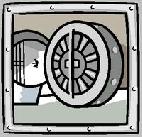
 |
|
| Financial Terms | |
| Intrinsic value of an option |
|
Information about financial, finance, business, accounting, payroll, inventory, investment, money, inventory control, stock trading, financial advisor, tax advisor, credit.
Main Page: business, payroll, tax advisor, financial advisor, financial, inventory control, investment, credit, Also see related: homes, homebuying, buy home, home buyer, condo, homebuyer, credit, home, first time homebuyer, |
Definition of Intrinsic value of an option
Intrinsic value of an optionThe amount by which an option is in-the-money. An option which is not in-themoney
Related Terms:NPV (net present value of cash flows)Same as PV, but usually includes a subtraction for an initial cash outlay. PV (present value of cash flows)the value in today’s dollars of cash flows that occur in different time periods. Abandonment optionThe option of terminating an investment earlier than originally planned. Adjusted present value (APV)The net present value analysis of an asset if financed solely by equity American optionAn option that may be exercised at any time up to and including the expiration date. American-style optionAn option contract that can be exercised at any time between the date of purchase and Arbitrage-free option-pricing modelsYield curve option-pricing models.  Asian optionoption based on the average price of the asset during the life of the option. Bargain-purchase-price optionGives the lessee the option to purchase the asset at a price below fair market Barrier optionsContracts with trigger points that, when crossed, automatically generate buying or selling of Basket optionsPackages that involve the exchange of more than two currencies against a base currency at Binomial option pricing modelAn option pricing model in which the underlying asset can take on only two Black-Scholes option-pricing modelA model for pricing call options based on arbitrage arguments that uses Bond valueWith respect to convertible bonds, the value the security would have if it were not convertible Book valueA company's book value is its total assets minus intangible assets and liabilities, such as debt. A Book value per shareThe ratio of stockholder equity to the average number of common shares. Book value  Call an optionTo exercise a call option. Call optionAn option contract that gives its holder the right (but not the obligation) to purchase a specified Carrying valueBook value. Cash-surrender valueAn amount the insurance company will pay if the policyholder ends a whole life Compound optionoption on an option. Conversion valueAlso called parity value, the value of a convertible security if it is converted immediately. Covered or hedge option strategiesStrategies that involve a position in an option as well as a position in the Currency optionAn option to buy or sell a foreign currency. Dealer optionsOver-the-counter options, such as those offered by government and mortgage-backed Delivery optionsThe options available to the seller of an interest rate futures contract, including the quality Doubling optionA sinking fund provision that may allow repurchase of twice the required number of bonds Down-and-in optionBarrier option that comes into existence if asset price hits a barrier. Down-and-out optionBarrier option that expires if asset price hits a barrier. Elasticity of an optionPercentage change in the value of an option given a 1% change in the value of the Embedded optionAn option that is part of the structure of a bond that provides either the bondholder or Equity optionsSecurities that give the holder the right to buy or sell a specified number of shares of stock, at European optionoption that may be exercised only at the expiration date. Related: american option. European-style optionAn option contract that can only be exercised on the expiration date. Exercise valueThe amount of advantage over a current market transaction provided by an in-the-money Exercising the optionThe act buying or selling the underlying asset via the option contract. Expected valueThe weighted average of a probability distribution. Expected value of perfect informationThe expected value if the future uncertain outcomes could be known Extraordinary positive valueA positive net present value. Face valueSee: Par value. Firm's net value of debtTotal firm value minus total firm debt. Foreign currency optionAn option that conveys the right to buy or sell a specified amount of foreign Future valueThe amount of cash at a specified date in the future that is equivalent in value to a specified Futures optionAn option on a futures contract. Related: options on physicals. Garmen-Kohlhagen option pricing modelA widely used model for pricing foreign currency options. Greenshoe optionoption that allows the underwriter for a new issue to buy and resell additional shares. Index and Option Market (IOM)A division of the CME established in 1982 for trading stock index Index optionA call or put option based on a stock market index. Intrinsic value of a firmThe present value of a firm's expected future net cash flows discounted by the Investment valueRelated:straight value. Irrational call optionThe implied call imbedded in the MBS. Identified as irrational because the call is Liquid yield option note (LYON)Zero-coupon, callable, putable, convertible bond invented by Merrill Liquidation valueNet amount that could be realized by selling the assets of a firm after paying the debt. Loan valueThe amount a policyholder may borrow against a whole life insurance policy at the interest rate Lookback optionAn option that allows the buyer to choose as the option strike price any price of the Liquid yield option note (LYON)Zero-coupon, callable, putable, convertible bond invented by Merrill Lynch & Co. Margin requirement (Options)The amount of cash an uncovered (naked) option writer is required to Market value1) The price at which a security is trading and could presumably be purchased or sold. Market value ratiosRatios that relate the market price of the firm's common stock to selected financial Market value-weighted indexAn index of a group of securities computed by calculating a weighted average Maturity valueRelated: par value. Multi-option financing facilityA syndicated confirmed credit line with attached options. Naked option strategiesAn unhedged strategy making exclusive use of one of the following: Long call Net adjusted present valueThe adjusted present value minus the initial cost of an investment. Net asset value (NAV)The value of a fund's investments. For a mutual fund, the net asset value per share Net book valueThe current book value of an asset or liability; that is, its original book value net of any Net present value (NPV)The present value of the expected future cash flows minus the cost. Net present value of growth opportunitiesA model valuing a firm in which net present value of new Net present value of future investmentsThe present value of the total sum of NPVs expected to result from Net present value ruleAn investment is worth making if it has a positive NPV. Projects with negative NPVs Net salvage valueThe after-tax net cash flow for terminating the project. OptionGives the buyer the right, but not the obligation, to buy or sell an asset at a set price on or before a Option elasticityThe percentage increase in an option's value given a 1% change in the value of the Option not to deliverIn the mortgage pipeline, an additional hedge placed in tandem with the forward or Option premiumThe option price. Option priceAlso called the option premium, the price paid by the buyer of the options contract for the right Option sellerAlso called the option writer , the party who grants a right to trade a security at a given price in Option writeroption seller. Option-adjusted spread (OAS)1) The spread over an issuer's spot rate curve, developed as a measure of Options contractA contract that, in exchange for the option price, gives the option buyer the right, but not Options contract multipleA constant, set at $100, which when multiplied by the cash index value gives the Options on physicalsInterest rate options written on fixed-income securities, as opposed to those written on Original face valueThe principal amount of the mortgage as of its issue date. Out-of-the-money optionA call option is out-of-the-money if the strike price is greater than the market price Par valueAlso called the maturity value or face value, the amount that the issuer agrees to pay at the maturity date. Parity valueRelated:conversion value Path dependent optionAn option whose value depends on the sequence of prices of the underlying asset Postponement optionThe option of postponing a project without eliminating the possibility of undertaking it. Present valueThe amount of cash today that is equivalent in value to a payment, or to a stream of payments, Present value factorFactor used to calculate an estimate of the present value of an amount to be received in Present value of growth opportunities (NPV)Net present value of investments the firm is expected to make Price value of a basis point (PVBP)Also called the dollar value of a basis point, a measure of the change in Put an optionTo exercise a put option. Put optionThis security gives investors the right to sell (or put) fixed number of shares at a fixed price within Quality optionAlso called the swap option, the seller's choice of deliverables in Treasury Bond and Treasury Relative valueThe attractiveness measured in terms of risk, liquidity, and return of one instrument relative to Replacement valueCurrent cost of replacing the firm's assets. Residual valueUsually refers to the value of a lessor's property at the time the lease expires. Salvage valueScrap value of plant and equipment. Related to : financial, finance, business, accounting, payroll, inventory, investment, money, inventory control, stock trading, financial advisor, tax advisor, credit. |